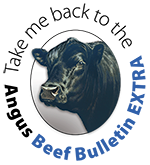Identifying the Hill Climbers and Bottom Dwellers
 The way cattle graze is a trait worth tracking.
The way cattle graze is a trait worth tracking.
by Megan Silveira, editorial intern
LOVELAND, Colo., June 21, 2018 — “Cattle are not like lawnmowers.”
While Derek Bailey’s opening statement during his presentation, “Development of Grazing Distribution Phenotypes,” during the Beef Improvement Federation Research Symposium and Convention in Loveland, Colo., might have drawn a few chuckles, cattlemen cannot deny the truth in his statement.
The lives of cattlemen would undoubtedly be made easier if cattle were like lawnmowers, consuming everything in an area in an even, consistent manner. Unfortunately, this is not reality, he said.
Bailey said in the western region of the United States, where cattle are raised on rangeland, grazing distribution has recently become a hot topic. Cattle are selective grazers, choosing to graze areas with higher biomass and greater nutrients while avoiding areas with toxins, steep slopes and areas at greater distance from water.
By avoiding certain areas, Bailey explained, livestock miss potential nutrients available from the land. Approximately one-third of many rangelands have grazeable areas that are not used.
“Grazing distribution has value,” Bailey said. “If you can get cattle to travel from water, you have more grazing opportunities.”
Bailey has been studying cattle in order to see where cows graze and why. He said grazing distribution is a “difficult and expensive trait to measure.” Data on the topic is difficult to condense, as it is so vast. He has narrowed the focus of his studies to terrain instead of diet to better understand grazing distribution.
He said terrain use is multi-dimensional. For his studies, Bailey integrated terrain attributes, normalizing slope, elevation and distance to water in the data he collected so the value for the average cow would equal 100. Bailey created two indices, a rough index including slope and elevation and a rolling index including slope, elevation and distance to water.
Bailey found cattle often fall into one of two categories in regard to grazing distribution. Cows will either be “bottom dwellers” that choose to eat grass available on flat ground or “hill climbers” willing to explore the rolling hills to find their next meal.
Bailey said he could find no phenotypical relationship between performance and terrain use in these females. He was, however, interested in the fact that even when these two groups of cattle were separated — eliminating the possibility that dominant cattle pushed others out of their desired area — they kept their particular grazing habit.
“I think there’s a heritable component to it,” Bailey said. While the age-old question of “nature or nurture” has not yet been solved in regard to grazing distribution, Bailey said this will be a focus for their upcoming studies.
With all this new data available about grazing distribution, Bailey is eager to provide ranchers with a way to use this information to their advantage.
“Even though it’s a complex trait, I think there’s still some potential,” Bailey said. “Instead of trying to mess with all the hassle, if we could create a genomic EPD, that could change everything.”
Bailey’s surveys have led him to believe ranchers are willing to pay for tests tracking animals' grazing movements to use this data to their advantage. While the knowledge ranchers and researchers possess about grazing distribution is constantly growing, Bailey said he believes this trait has the ability to revolutionize the cattle industry.
Editor’s Note: The articles used within this site represent a mixture of copyrights. If you would like to reprint or repost an article, you must first request permission of Angus Media by contacting the editor at 816-383-5200; 3201 Frederick Ave., Saint Joseph, MO 64506. Angus Media claims copyright to this web site as presented. We welcome educational venues and cattlemen to link to this site as a service to their audience.


